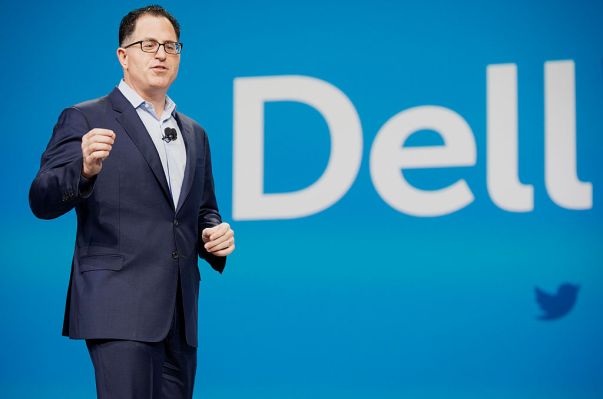When Dell announced it was spinning out VMware yesterday, the move itself wasn’t surprising; there had been public speculation for some time. But Dell could have gone a number of ways in this deal, despite its choice to spin VMware out as a separate company with a constituent dividend instead of an outright sale.
The dividend route, which involves a payment to shareholders between $11.5 billion and $12 billion, has the advantage of being tax-free (or at least that’s what Dell hopes as it petitions the IRS). For Dell, which owns 81% of VMware, the dividend translates to somewhere between $9.3 billion and $9.7 billion in cash, which the company plans to use to pay down a portion of the huge debt it still holds from its $58 billion EMC purchase in 2016.
Dell hopes to have its cake and eat it too with this deal: It generates a large slug of cash to use for personal debt relief while securing a five-year commercial deal that should keep the two companies closely aligned.
VMware was the crown jewel in that transaction, giving Dell an inroad to the cloud it had lacked prior to the deal. For context, VMware popularized the notion of the virtual machine, a concept that led to the development of cloud computing as we know it today. It has since expanded much more broadly beyond that, giving Dell a solid foothold in cloud native computing.
Dell hopes to have its cake and eat it too with this deal: It generates a large slug of cash to use for personal debt relief while securing a five-year commercial deal that should keep the two companies closely aligned. Dell CEO Michael Dell will remain chairman of the VMware board, which should help smooth the post-spinout relationship.
But could Dell have extracted more cash out of the deal?
Doing what’s best for everyone
Patrick Moorhead, principal analyst at Moor Insights and Strategies, says that beyond the cash transaction, the deal provides a way for the companies to continue working closely together with the least amount of disruption.
“In the end, this move is more about maximizing the Dell and VMware stock price [in a way that] doesn’t impact customers, ISVs or the channel. Wall Street wasn’t valuing the two companies together nearly as [strongly] as I believe it will as separate entities,” Moorhead said.
He said it also enables Dell and VMware to continue to be tightly aligned from a business perspective. “Given the five-year strategic agreement, it doesn’t look like much will change operationally. The optics might allow Dell Tech to partner more closely with VMware competitors and vice versa, but the two companies were already doing this,” he added.
While having VMware more directly integrated into Dell has certainly been good for Dell, Moorhead pointed out that it was more of a symbiotic relationship than many realized. “Unknown to many, Dell brought a lot of VMware’s recent growth and Dell benefitted of course, as VMWare’s ‘first’ partner on new initiatives,” he told TechCrunch.
Debt shifts to VMware
While Dell clearly could have gone in another direction like selling stock outright, it’s likely that the company saw this as the best way to go to reduce its debt load while avoiding taxes. The company’s debt load will fall under its proposed plan from a roughly 2.0x net debt to adjusted EBITDA ratio to a 1.6x multiple. That’s certainly an improvement, but the scale of Dell’s continuing financial obligations underscores how much debt the company will continue to carry.
Dell intends to use its VMware dividend to pay down so-called core debt and margin debt. The company’s debts related to its financial services business (“DFS”) will remain untouched. Considering the deal from a high level, it can be viewed as a debt transference; Dell will reduce its overall debt load through the spin-out, while VMware will take on debt.
Why will VMware go into debt thanks to the deal? Because it doesn’t have nearly enough cash to pay for the special dividend without help. As its deck on the transaction makes clear, the $11.5 billion to $12 billion payout will be funded with “$2.5-$3.5 billion cash and incremental debt.” Presuming the larger payout, VMware could be forced to raise around $8.5 billion in debt for the deal to work.
Is that a lot for the company? Yes and no. Yes, it’s a high dollar amount that VMware expects to spend two years’ “free cash flow primarily to de-lever,” per its own reporting. And no, in that borrowing costs are modest in today’s economy and VMware generated $4.4 billion in operating cash flow in its last fiscal year.
Playing the what-if game, what if Dell had decided on doing something more drastic with its VMware stake, like selling the majority of it? Such a transaction could have reduced its debt load further, but at the price of a steep tax penalty. Given that selling blocks of VMware stock could have impacted the latter company’s share price, it could have been unattractive from several perspectives.
Under the current plan, Dell reduces its debt, improves its credit rating, avoids a tax bill and gets to give its shareholders 0.44 VMware shares for every piece of Dell equity that they own. Perhaps the deal is the compromise that made every party happy, even if Dell will retain more debt on its balance sheet than likely the company or its investors, would have liked.
For Dell, the VMware deal could represent the end of a long, mostly public dance, one that should see it keep its hands on most of what it bought in the EMC deal, yet with a cleaner balance sheet. Perhaps with this chapter closed and Dell sitting more contentedly with a way to borrow less expensively thanks to its reduced balance-sheet leverage, it can concentrate less on debt and more on growth.
